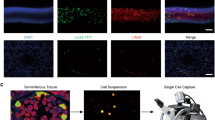Summary
We describe the detection of ectopic (“illegitimate”) transcripts of the proacrosin and protamine 2 genes, which are specific for human spermatogenesis, in non-cultured peripheral blood lymphocytes. After specifically-primed reverse transcription of total lymphocyte RNA, these rare transcripts can be directly visualised after two rounds of polymerase chain reaction with nested primers. Sequence and restriction analyses of the corresponding fragments have confirmed that transcripts of proacrosin and protamine 2 are present in the lymphocytes not only of males, but also of adult females.
Similar content being viewed by others
References
Adham IM, Klemm U, Maier W-M, Engel W (1990) Molecular cloning of human preproacrosin cDNA. Hum Genet 84:125–128
Baba T, Kashiwabara S, Watanabe K, Itoh H, Michikawa Y, Kimura K, Takada M, Fukamizu A, Arai J (1989) Activation and maturation mechanism of boar acrosin zymogen based on the deduced primary structure. J Biol Chem 264:11920–11927
Balhorn R (1989) Mammalian protamines: structure and molecular interactions. In: Adolph KW (ed) Molecular biology of chromosome function. Springer, Berlin Heidelberg New York, pp 366–395
Berg L-P, Wieland K, Millar DS, Schloesser M, Wagner M, Kakkar VV, Reiss J, Cooper DN (1990) Detection of a novel point mutation causing haemophilia A by direct sequencing of ectopically expressed factor VIII gene transcripts. Hum Genet 85:655–658
Chelly J, Kaplan JC, Maire P, Gautron S, Kahn A (1988) Transcription of the dystrophin gene in human muscle and non-muscle tissues. Nature 333:858–860
Chelly J, Concordet J-P, Kaplan JC, Kahn A (1989) Illegitimate transcription: transcription of any geny in any cell type. Proc Natl Acad Sci USA 86:2617–2621
Chomczynski P, Sacchi N (1987) Single-step method of RNA isolation by acid guanidinium thiocyanate-phenol-chloroform extraction. Anal Biochem 162:156–159
Domenjoud L, Nussbaum G, Adham IM, Greeske G, Engel W (1990) Genomic sequences of human protamines whose genes, PRM1 and PRM2, are clustered. Genomics 8:127–133
Hecht NB (1990) Regulation of haploid expressed genes in male germ lines. J Reprod Fertil 88:679–693
Jones R, Brown CR, Lancaster RT (1988) Carbohydrate-binding properties of boar sperm proacrosin and assessment of its role in sperm-egg recognition and adhesion during fertilization. Development 102:781–792
Kallajoki M, Parvinen M, Suominen JJO (1986) Expression of acrosin during mouse spermatogenesis: a biochemical and immunochemical analysis by monoclonal antibody C11H. Biol Reprod 35:157–165
Keime S, Adham IM, Engel W (1990) Nucleotide sequence and exon-intron organization of the human proacrosin gene. Eur J Biochem 190:195–200
Kleene KC, Distel RJ, Hecht NB (1984) Translational regulation and deadenylation of a protamine mRNA during spermatogenesis in the mouse. Dev Biol 105:71–79
Klemm U, Maier W-M, Tsaousidou S, Adham IM, Wilson K, Engel W (1990) Mouse preproacrosin: cDNA sequence, primary structure and postmeiotic expression in spermatogenesis. Differentiation 42:160–166
Polakoski KL, Parish RF (1977) Boar proacrosin purification and preliminary activation studies of proacrosin isolated from ejaculated boar sperm. J Biol Chem 252:1888–1894
Saling PM (1981) Involvement of trypsin-like activity in binding of mouse spermatozoa to zonae pellucidae. Proc Natl Acad Sci USA 78:6231–6235
Sambrook J, Fritsch EF, Maniatis T (1989) Molecular cloning: a laboratory manual, 2nd edn. Cold Spring Harbor Laboratory, Cold Spring Harbor, NY
Sarkar G, Sommer SS (1989) Access to a messenger RNA sequence or its protein product is not limited by tissue or species specificity. Science 244:331–334
Schloesser M, Slomski R, Wagner M, Reiss J, Berg L-P, Kakkar W, Cooper DN (1990) Characterization of pathological dysrophin transcripts from the lymphocytes of a muscular dystrophy carrier. Mol Biol Med 7:519–523
Töpfer-Petersen E, Henschen A (1988) Zona pellucida binding of boar sperm acrosin is not correlated with proteolytic activity. Biol Chem Hoppe Seyler 369:69–76
Author information
Authors and Affiliations
Rights and permissions
About this article
Cite this article
Slomski, R., Schloesser, M., Chlebowska, H. et al. Detection of human spermatid-specific transcripts in peripheral blood lymphocytes of males and females. Hum Genet 87, 307–310 (1991). https://doi.org/10.1007/BF00200909
Received:
Revised:
Issue Date:
DOI: https://doi.org/10.1007/BF00200909




